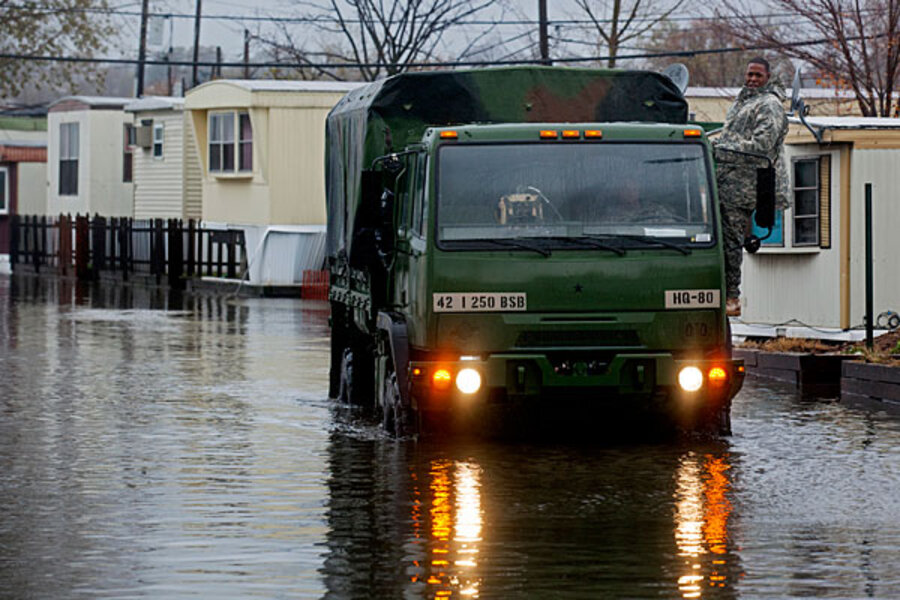Hurricane Sandy response: Officials get good marks, so far
| Boston
Though it is too early to make definitive assessments, rescue and relief efforts along the storm-hit East Coast have won some early public praise.
Local and state officials were lauding federal officials for their preparations, and federal officials were praising local crews for their quick action in providing shelter in flood-risk zones, guiding others to safety, and mounting door-to-door rescues in one New Jersey community ravaged by surprise river overflow.
On Tuesday, emergency personnel including National Guard forces continued to respond to challenges from North Carolina northward, and the efforts promise to remain intense for days, as efforts to restore electric power and recover from floods continue.
Despite the enormous work ahead – and the damage left behind – Sandy's aftermath has not yet brought significant finger-pointing, though.
"The folks at FEMA ... have been excellent," said New Jersey Gov. Chris Christie, referring to the Federal Emergency Management Agency.
Mr. Christie, engaged in his own mobilization efforts at the state level, recounted late-night conversations with President Obama and with FEMA personnel, preparing the way for federal disaster relief.
"The president has been outstanding in this," said Christie, a Republican governor who has been vocal in his support for Mitt Romney in the presidential race.
Others agree with the governor. "I think the federal response was positioned well," retired Lt. Gen. Russel Honoré said in an interview on CNN Tuesday. He added that, as governors have called up more uniformed personnel, "I think the National Guard is doing a great job."
Lieutenant General Honoré, who helped coordinate relief efforts in New Orleans after the devastation of Hurricane Katrina in 2005, said that in the first few hours of a disaster state and local responders typically play the most vital role in keeping people safe.
Obama echoed that sentiment Tuesday, praising local officials and governors including Christie and Andrew Cuomo of New York, saying their their preparation work and efforts since the storm struck have saved lives.
Verbal jabs exchanged between Christie and Atlantic City Mayor Lorenzo Langford are the exception, not the rule, in Sandy's wake. Christie fretted publicly that some comments by Mayor Langford had prompted some residents to enter a shelter rather than evacuate. The shelter later became the scene of flood-rescue efforts Monday by the National Guard.
Langford on Tuesday called Christie's comments "dead wrong," New Jersey's Star-Ledger reported. The mayor said he was urging evacuation, and that his plans to move people inland from the shelter were thwarted by the storm's fast-moving surge.
As recovery efforts ramp up regionwide, the federal role will become more important. For instance, Obama has signed declarations opening the way for FEMA relief in states from Rhode Island to Virginia. FEMA assistance after the storm will include funds to help with debris removal, grants to affected families for temporary housing and home repairs, and low-cost loans to cover uninsured property losses. Other aid programs managed by the agency aim to help business owners recover.
Meanwhile, National Guard troops were called up or placed on alert from Florida to Maine, as governors moved to help their residents or to offer aid to neighboring states. The West Virginia National Guard had teams in eight counties to help local authorities amid Sandy-related snowstorms.
One of the storm's most dramatic rescue efforts was at sea off the North Carolina coast, where Coast Guard helicopters saved 14 crew members of the Bounty, the sailing ship once used in a Hollywood movie.
Floodwater rescues were common in New Jersey and New York, which took the brunt of the storm. In Hoboken, N.J., many residents faced standing water outside their doorsteps, with Mayor Dawn Zimmer warning residents that the potential for submerged live electric wires. In Moonachie, N.J., Sandy's tidal surge sent water over a riverbank and gushing out of storm drains, setting off a frantic rescue of people stranded in houses and rooftops.
In some situations, the best that responders have been able to do so far is simply to warn people to stay out of harm's way.
A power outage at a water treatment plant in Maryland resulted in a sewage overflow of 2 million gallons per hour into a flooded section of the Little Patuxent River. Because of the severity of the storm, officials said they could take no immediate action to mitigate the river's contamination.
Obama warned Tuesday that the storm remains dangerous as it moves slowly inland. "There are still risks of flooding," winds, and downed power lines, he said at Red Cross headquarters in Washington. He encouraged Americans in Sandy's path to be careful but also to reach out to neighbors who may need help.
"The public can be the eyes and ears, in terms of identifying unmet needs," Obama said. That echoed a message that other emergency-response experts have sounded: that Sandy has in some regions spawned greater needs than first responders can easily handle.
With that in view, Obama urged patience and resilience by citizens. "Be good neighbors for the duration, until everybody is back on their feet."
• Material from the Associated Press was used in this report.







